#jerseyman
Explore tagged Tumblr posts
Text




Jerseyman Island August 19 2022.
3 notes
·
View notes
Text
listening to leATHERMØUTH whilst crocheting in bed, wearing the fuzziest clothes imaginable feels like being a physical incarnation of mental illness but saying ":3" ":D" ":P" in text messages yknow
#leathermouth#frnk#frnkiero#leathermøuth#frank iero the fucking insane jerseyman#showing clear symptoms of mee:3
4 notes
·
View notes
Text
Tbh the denonym also extends to some two-word-named states like New Jersey and New York. I don't really know what the solution to this would be... you can say New Yorker but I feel like it should all be contained within one word instead of two. With New Jersey it's also kind of hard to find the right denonym modifier although luckily people are more used to just calling it Jersey. But still what do you call someone from Jersey... I just looked up what people from old Jersey are called and Wikipedia says they are called Jerseymen. So it's gendered now... well in my personal opinion I wouldn't mind being called a new jerseyman if I was from New Jersey but not a man because I'd think of it like how human and woman have the word man in it. Like maybe "jersey" can be the same type of word component as "wo" or "hu" is. But I can see why someone wouldn't want to be called a man if they aren't one like how some women opt to write it as womyn wimmen or womxn etc. We should ask all 9 and a half million people from New Jersey what they think and then make a decision.
4 notes
·
View notes
Text
Cider history fact of the day. In 1801 it was estimated that Jersey in the Chanel Islands produced 2 million gallons of cider a year. Little wine or beer was produced and cider took over from mead, made from honey, as the Jerseyman's first choice of tipple. #cider #ciderhistory

0 notes
Video
youtube
When your NFL career is over, what do you do next? This is the story of Jersey Man founder, Ken Dunek
#nfl#publishing#jerseyman#entrepreneur#outofthebox#success#philadelphia#philly#jerseyshore#new jersey#magazine#money#career#motivation#inspiration#advertising#nfl football#concussion#literature#philadelphia eagles
5 notes
·
View notes
Photo

It's getting Hott🔥🔥🔥...She's so Grown Now!!! #nbajersey #nbafans #BULLS #chicagobulls #chicagobears #myliecyrus #sexywomanphotos #summeroutfit #jerseysforsale #jerseyman #jerzeyman #sportsfashion #sportsfan https://www.instagram.com/p/Bvpm5FzA3DM/?utm_source=ig_tumblr_share&igshid=iszsw77t4qoh
#nbajersey#nbafans#bulls#chicagobulls#chicagobears#myliecyrus#sexywomanphotos#summeroutfit#jerseysforsale#jerseyman#jerzeyman#sportsfashion#sportsfan
0 notes
Photo

The Mysterious Super Keronian,
New(Shin) Jerseyman!!
Shin Keroro in the Jersey Transformation Suit (Episode 348)
:)
4 notes
·
View notes
Text
The Lingering Leather of Antoine Le Blanc
Judge Gabriel Ford sat in his courtroom with the fate of another human being in his hands. The stories he had just heard were horrific, blood soaked, and to him the max sentence just didn't seem to spell justice for the Sayre family. He decreed what everyone expected, the man before him would "...be hung by the neck till you are dead." But, there was more, much more to come for the future corpse standing in the courtroom.
Antoine Le Blanc arrived in New York in April 1883 as a man uprooted. Disowned from his affluent family in France and finding himself in a massive city with no means of obtaining money or communicating in any language besides French, the thirty-one year old Le Blanc spent his first days in this new country seeking work. He wanted to bring fortune back into his hands. What he ended up holding was farming tools.
The Sayres of Morristown, New Jersey were a prominent farming family consisting of Mr. Samuel Sayre, his wife Sarah, and their young servant girl Pheobe. When he was hired by the family Le Blanc may not have understood what he signed up for. The work was brutal, the days were long, and the lodging was a dark and dank room in the Sayre’s cellar. These factors might have made the job miserable, but after two weeks of labor Le Blanc had not been paid and this, according to him, was both inexcusable and unforgivable.
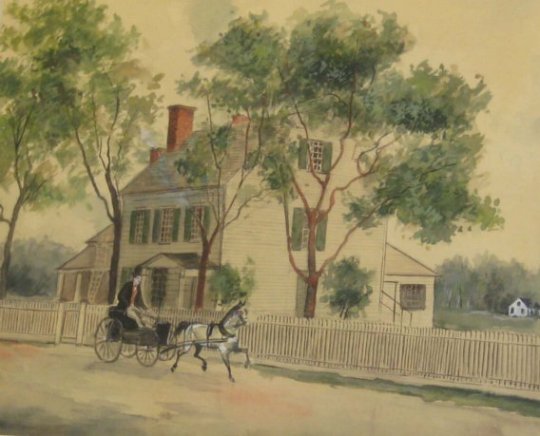
Illustration of the Sayre home in Morristown, New Jersey.
On the evening of May 11th 1833 Le Blanc was spending some time at a local hotel drinking until late into the evening. He was deeply unhappy in his situation and decided he would no longer be under the control of the Sayre family. At approximately 10:30pm Samuel Sayre was at home when Le Blanc frantically ran up to him, gesturing wildly, and conveying that he had to follow him out to the stables immediately. Le Blanc entered the barn first and when Sayre followed behind him he was quickly cut down. Le Blanc had a shovel at hand, and when his employer entered the barn he proceeded to repeatedly unleash it on his head. With pieces of Mr. Sayre’s head strewn all over the barn Le Blanc made his way back to the house and repeated the same charade to his wife Sarah, luring her to the barn and committing her to the same grisly fate as her husband. Lastly, Le Blanc gripped a club and crept into the bedroom where Phoebe was sleeping. She was extinguished with one swing to her skull.
Once Le Blanc was done unleashing pure horror he set out to take what he wanted all along, cash and valuables. Going through the Sayre home he grabbed anything of value that could be shoved inside a pillowcase before fleeing the scene on one of the family horses. In Le Blanc’s mind this was only the first step of his return journey home. He would get to New York, board a ship to Germany, and arrive back in Europe with money in his bloodstained hands. But, the murderer never got out of New Jersey. The morning after the murder Lewis Halsey was walking along a road when he saw some unusual objects. When he picked them up to inspect them he was probably horrified to see the monogram of his good friend Samuel Sayre. Halsey and some people from town made their way to the Sayre home expecting a robbery, but what they found was a nightmare. A massive amount of blood and the bodies of his friends buried under a pile of manure.
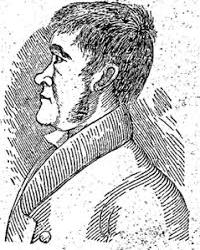
Sketch of Antoine Le Blanc.
Sheriff George Ludlow was tasked with finding the monster, but the pursuit and capture of Le Blanc was quicker and easier than anyone expected. Not because the killer’s hiding place had failed, but because the Sayre belongings found in the road were only some of the many items that fell out of the pillowcase as he made his escape. The trail of belongings led directly to the fugitive, sitting inside a Hackensack Meadows tavern with Sayre’s pillowcase next to him. When he spied Ludlow approaching the tavern he panicked and ran for the back exit, but it was no use. Less than one day into his great escape Le Blanc was in custody and headed back to Morristown to face judgement.
For just over three months Le Blanc wallowed in a cell waiting for his day in court. He never denied the charge, confessing in prison and detailing how he sat in the hotel the night of the crime waiting until the perfect moment to return after the Sayre family were retired for the evening. On August 13th 1883 Le Blanc walked into the Morris County Courthouse where his trial, more a formality than anything else, was carried out under the eyes of Judge Gabriel Ford. The jury deliberated for only twenty minutes before giving the verdict that everyone already knew was coming. The first part of the sentence was obvious, “….that you be hung by the neck till you are dead” but it was a second part that was unexpected:
“And it is further considered by the court, that after execution is done, your body will be delivered to Dr. Canfield, a surgeon, for dissection. And may God have mercy upon your soul.”
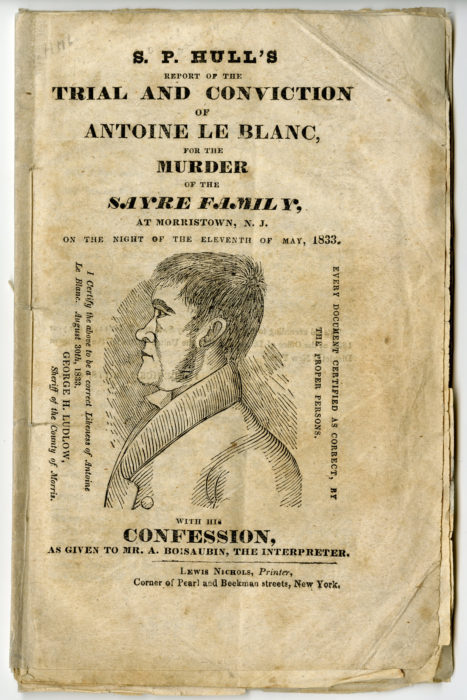
Printed account of the confession, trial, and execution of Antoine Le Blanc. Image via MorristownGreen.com and North Jersey History & Genealogy Center.
On September 6th 1833 thousands of people descended onto the Morristown Green in Morristown to witness the demise of the man dubbed a monster. Custom gallows, constructed at the local ironworks, were hauled to the Green and designed to give the maximum visual effect. Le Blanc would be tied at the neck and a system of ropes, pulleys, and weights was configured so that when a rope was cut a weight would fall and hoist the body eight feet into the air in order to accommodate the thousands gathered and sitting on roofs to catch a better view of the execution.
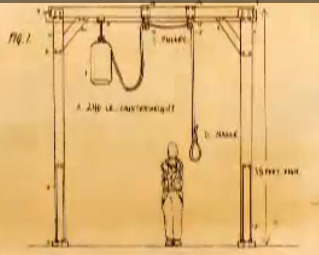
Diagram of the gallows used on Antoine Le Blanc.
According to an article from The Jerseyman:
“No such crowd as witnesses it was, probably, ever in the town before or since. People came by the thousands, not only from within the bounds of Morris but from Essex, Union, Somerset, Warren, Sussex and all other contiguous territory. Horses and wagons at times blocked the roads, and were tied from the Park on the roads leading from it for a mile or more out in every direction. Many people brought their lunches, but all supplies gave out early and scores went hungry.”
It is estimated that 12,000 people witnessed Antoine Le Blanc’s body launch into the air and twist for two minutes. It hung for thirty-five minutes more before he was cut down and loaded into a wagon. The worst was yet to come for the corpse.
After his demise Le Blanc’s body was handed over to Dr. Canfield and a Princeton professor named Dr. Joseph Henry. It was not unheard for the body of a murderer to be handed over for dissection, what was unusual was them being handed over to be used in experiments. Le Blanc’s arms and legs were opened up to expose the muscles and nerves before he was hooked up to a battery. The good doctors then went about surging his body with different measures of electricity to test how it affected muscle contractions. Allegedly his legs tensed, his eyes rolled, and they were even able to bring a slight smile to his dead face before they concluded their gruesome tests. Once finished a death mask was cast and according to some stories Le Blanc’s ears were cut off and given away. And yet, they still were not done with him.
In a highly unusual move, the skin was stripped from Le Blanc’s body and sent to Atno Tannery in Morristown. Here the skin was treated as an animal hide and turned into “charming little keepsakes” including book jackets, lamp shades, and wallets all signed by Sheriff Ludlow to prove their authenticity. As reported in The Jerseyman:
“Hon. A.W. Cutler of Morristown was said to have had a piece of the skin, and Hon. Thos. Carter of Newton, has a pocketbook made from it, bearing the endorsement by Sheriff Ludlow that it is the Simon-pure goods.”
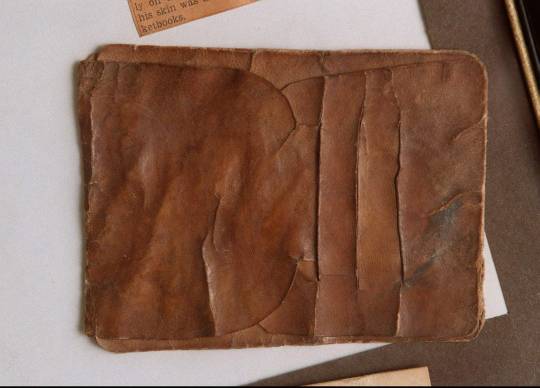
Wallet made from the skin of Antoine Le Blanc. Image via NJ.com.
Antoine Le Blanc’s execution was the last public hanging in Morristown and the bodies of the Sayre family were buried in the town’s Presbyterian Church cemetery. Although the town moved on from the murder, pieces of the horrific crime continued to permeate the region. The keepsakes made from Le Blanc’s skin circulated from hand to hand and in the almost 200 years since the killings segments of the story including death masks, skin wallets, and the bones of the long-dead Le Blanc have popped up unexpectedly inside the innards of old buildings and in private collections kept quiet over generations.
There are dozens of mementos that have never been located.
Today the death mask of Antoine Le Blanc and one of the infamous skin wallets can be found inside the collection of the North Jersey History & Genealogy Center.
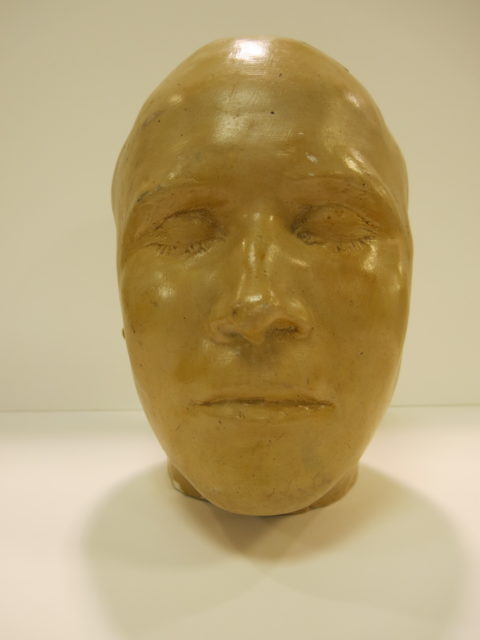
Death mask of Antoine Le Blanc. Image via MorristownGreen.com and the North Jersey History & Genealogy Center.
#HushedUpHistory#featuredarticles#history#NewJersey#NewJerseyhistory#MorristownHistory#forgottenhistory#horrorhistory#terrorhistory#horrorstory#truecrime#weirdhistory#strangehistory#historyisweird#historyiswild#tragictale#tragedy#RIP#deathmask#leatherworking#artifact#tragicend#AntoineLeBlanc#famoustrial#famouscrime#wallet#scarystory#truestory#truthisstrangerthanfiction#crimehistory
2 notes
·
View notes
Text
Casualties of War: The Influenza Epidemic of 1918
During the spring of 1918, the long and protracted stalemate on the front lines had finally tipped in favor of the Allies with the United States’ entry into World War I, in which the British, French, Russian, and other Allied nations were pitted against the Axis powers of Germany, Austria, and the Ottoman Empire.

As if to deprive the nations of the world of the hard fought peace, a global pandemic claimed the lives of those young men and women who were lucky enough to have escaped death. The Influenza epidemic of 1918 and 1919 killed more individuals worldwide than had died in the Great War — an estimated 50 million people — and it became one of the deadliest epidemics in recorded history.
While influenza is typically only fatal among some infants and elderly victims, the 1918 strain was deadliest among those between the ages twenty and forty years old, with 28% of Americans contracting the disease that ultimately killed approximately 675,000 (many times the number of servicemen who died in combat).

As troops deployed thousands of miles overseas the virus traveled with them, spreading faster than medical professionals and authorities could react. Most governments censored any news that negatively affected morale, thus, citizens were unaware of the epidemic until it was too late. The epidemic was initially referred to as “Spanish Flu” because neutral Spain still possessed a free press and was the first country to report the pandemic as it spread throughout the Iberian Peninsula.
Unlike today, in 1918 there were no laboratory tests, vaccines, or antiviral medications with which to treat influenza, and no antibiotics to tame its lethal companion pneumonia. Morristown’s Board of Health banned large gatherings in response to the increasing number of fatalities throughout the state. Schools, saloons, dance halls, and cinemas shuttered, and even public funerals were prohibited. Church services and battalion drills were also halted. By January, 1919, over 18,300 deaths had already been reported by The Jerseyman newspaper.

Dedicated doctors and nurses served on the front lines of the war against the influenza pandemic, fighting to ascertain disease vectors and determine treatment methods all while knowing they could fall victim themselves. Poor conditions on the battlefield helped the virus proliferate as soldiers’ immune systems were weakened by malnourished, injury, and stress. Many victims suffered death from an extreme form of pneumonia that caused violent coughing.

Long after hostilities ceased, when the Armistice was signed, and the final parades had dispersed, towns across the nation built memorials to their war dead. Lost among the etched names of those killed in combat were the victims of influenza, since most monuments excluded soldiers who died of illness or other non-combat related causes. Similarly, no physical memorials exist to the millions of civilians who died in one of the world’s greatest holocausts.
Sources:
David M. Kennedy, Over Here: The First World War and American Society, Oxford: Oxford University Press, 1980, pg 189.
CDC.gov/features/1918-flu-pandemic.
1 note
·
View note
Photo

They say a picture is worth a thousand words, but this was worth a thousand emotions. Drop a V if you remember the time when Captain Kohli dedicated Jersey No. 12 to the 12th Man Army. 17,18,19most dengerous in the world abD&vkohli ,covid.... Got an opinion about this? See what others are saying.... See MORE -> https://worldnewsinpictures.com/worldphotographyday #TheyDrop #TheyDropCaptain #Jersey #JerseyMan #JerseyManArmy #SeeSee #SeeSeeMORE #picture #emotions
0 notes
Photo

Further British GT heartache for Butel in Spa. #britishGT #optimummotorsport #astonmartinracing #35 #spafrancorchamps #sprintMG #sportstalent #ringautomotive #commaoil #lucasbatteries #ringautomotive #procleanUK #sponsorship #motorsport A difficult Donington weekend was put well behind Jerseyman Jack Butel in the British GT championship last time out, the Optimum Motorsport driver set his sights on a positive result at Spa Francorchamps in Belgium (20/21 July).
0 notes
Text
‘Becque à Barbe / Face to face’ - Martin Toft

The Last 100: A Portrait of Jèrriais
On 19 December 2016 the United Nations General Assembly proclaimed 2019 as the International Year of Indigenous Languages. In that same year myself and @garethsyvret (former Photo Archivist at @societejersiaise) began research around Jérriais – the island of Jersey’s native language of Norman French. In the 2001 Jersey Census people were asked questions about their use and understanding of Jèrriais. In the census Islanders were asked which language they spoke. Out of a total of 87,186 residents of Jersey in 2001, 2874 spoke or understood Jèrriais at some level (3.3%). Out of this number 113 people described Jèrriais as their main language. There was no language question in the most recent census of 2011.
The project, The Last 100: A Portrait of Jèrriais hosted by the Sociète Jersiaise Photographic Archive asks: who were the hundred and thirteen and seeks to photograph them and hear their stories. In an island made of granite most names are forms of the Celtic, Norse and Latin words for rock. Most Jersey place names are also using proper French rather than Jèrriais, although there are variants of place names that native speakers would have used in a local context. Juxtaposed with portraits of Jérriais speakers are a series photographs of Jersey rocks that are all designated as Special Sites of Interest (SSIs); important geological outcrops that are protected from development and preserved for future public enjoyment and research purposes. The native speakers of Jersey French could also be classified as Special People of Interest (SPIs) and the concept of juxtaposing a portrait, or rather face of a native speaker with an image of a rock face is to examine how Jérriais is used, not only to describe characteristics of people but also how it is embedded in Jersey’s native tongue in describing a landscape. On a linguistic level the project is exploring the space between the formal, etymological and vernacular use of Jérriais. Photography as a medium is mute and the challenge is to photograph, what essentially is a spoken language.
More info: https://www.bailiwickexpress.com/jsy/news/watch-who-are-113-jerriais-speakers/#.XP9gxIgzY2w
How to record a spoken language? A vital project is currently underway in Jersey to save the island's indigenous language Jèrriais (Jersey French) and create an audio archive of spoken words. Linguists Dr Mari Jones from Cambridge University and Dr Julia Sallabank, SOAS are currently in Jersey leading community workshops on how to record conversations among native speakers. At Archisle we will soon be embarking on a new project, The Last 100, making a set of large-format portraits of islanders who indicated in a recent consensus that Jèrriais were their first language. Other images will also be made that conceptually explore the language of Jèrriais' unique sound, symbolism and semantics, including its common use in Jersey place-names, such as rocks.
True Jerseyman, Francois Le Maistre, son of Frank Le Maistre from St Ouen who in 1966 published his remarkable dictionnaire Jersiais-Français - a collection of more than 17,000 words and phrases in Jèrriais will be one of the first to be photographed as part of our visual anthropology of first language speakers. In the meantime if you want to get involved with the above Jerriais community audio recording project click here. https://www.facebook.com/events/1921127284800222/
#island#islands#isle#isles#jersey#channel islands#martin toft#photography#photographer#art#Jérriais#the last 100#Becque à Barbe#visual anthropology#Archisle#language
1 note
·
View note
Video
instagram
Down to the Final Four🏀🏀🏀⛹️⛹️♀️⛹️⛹️♀️ #nbajersey #nbahalloffame #sexywomanphotos #jerseyman #jerseyman #chicagobulls #atlantafalconsjerseys #atlantafalcons #ncaamensbasketball #zionwilliamson https://www.instagram.com/p/BvuTJQpAJ1R/?utm_source=ig_tumblr_share&igshid=1epvg45qx2jl2
#nbajersey#nbahalloffame#sexywomanphotos#jerseyman#chicagobulls#atlantafalconsjerseys#atlantafalcons#ncaamensbasketball#zionwilliamson
0 notes
Photo

Grève De Lecq looking gorgeous in the hazy sunshine yesterday. The last few months I’ve been dating a local Jerseyman and I’ve visited more new places than I have since I arrived on the island. Yesterday he took me to Le Câtel De Lecq, a kind of humpy hill that is actually the site of an old iron age fort. The view was spectacular. I love that I am still discovering new places here. . . . . . #jerseyci #grevedelecq #thisanxiousadventurer #lecatel #ironagefort #bankholidayhike #maydaybankholiday #summerishere #jerseychannelislands #localtourist #localknowledge #discoveringthefamiliar (at La Gréve De Lecq Beach Jersey) https://www.instagram.com/p/BxLB77lJBYl/?utm_source=ig_tumblr_share&igshid=l67g17cj22i7
#jerseyci#grevedelecq#thisanxiousadventurer#lecatel#ironagefort#bankholidayhike#maydaybankholiday#summerishere#jerseychannelislands#localtourist#localknowledge#discoveringthefamiliar
0 notes
Text
“A firm, living, alert and quick intelligence characterizes the Jerseyman, who could, if he wished, be French. The Guernsians, though quite as clear-sighted and reliable, are slower.”
Victor Hugo, allowing Jersey natives The Ultimate Compliment (sorry, Guernsey! You’re great, but you’re not quite “Worthy of Being French” great)
13 notes
·
View notes
Text
Premiership: Bath v London Irish (Sat)
Premiership: Bath v London Irish (Sat)
Premiership: Bath v London Irish (Sat)
Gloucester-bound Matt Banahan’s 12-year career at Bath ends against the side that signed the Jerseyman to their academy as a teenager
Aviva Premiership Venue: The Recreation Ground Date: Saturday, 5 May Kick-off: 16:00 BST Coverage: Live commentary on BBC local radio and live scores on the BBC Sport website
Anthony Perenise will play his 100th game for Bath and Matt Banahan his last against relegated London Irish.
Lucas Noguera and Matt Garvey come into the pack, while Gloucester-bound Banahan moves to centre to allow for Cooper Vuna’s inclusion on the wing.
Irish hand a Premiership debut to winger Ben Loader, while centre Fergus Mulchrone also returns.
Club-record appearance holder David Paice is among the replacements for his final match before retirement.
Bath: Homer; Vuna, Banahan, Wilson, Brew; Priestland, Fotuali’i; Noguera, Dunn, Perenise, Garvey (capt), Stooke, Ellis, Louw, Faletau.
Replacements: Walker, Vaughan, Delmas, Phillips, Mercer, Green, Burns, Clark.
London Irish: Tonks; Cokanasigsa, Fowlie, Mulchrone, Loader; Brophy Clews, Steele; Elrington, Porecki, Hoskins, Van der Merwe (capt), De Chaves, McNally, Cowan, Treviranus.
Replacements: Paice, Franks, Du Plessis, Cooke, Basham, Van Zyl, Williams, Lewington.
Referee: Matthew Carley.
BBC Sport – Rugby Union ultras_FC_Barcelona
ultras FC Barcelona - https://ultrasfcb.com/rugby-union/3336/
#Barcelona
0 notes